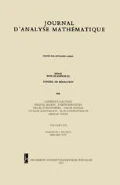Abstract
A sequence {x n } ∞1 in the unit interval [0, 1) = ℝ/ℤ is called Borel-Cantelli, or BC, if for all non-increasing sequences of positive real numbers {a n } with 48001013 1. \(\sum\nolimits_{i = 1}^\infty {} {a_i} = \infty \), the set
has full Lebesgue measure. (Speaking informally, BC sequences are sequences for which a natural converse to the Borel-Cantelli Theorem holds).
The notion of BC sequences is motivated by the monotone shrinking target property for dynamical systems, but our approach is from a geometric rather than dynamical perspective. A sufficient condition, a necessary condition and a necessary and sufficient condition for a sequence to be BC are established. A number of examples of BC sequences and sequences that are not BC are also presented.
The property of a sequence to be BC is a delicate Diophantine property. For example, the orbits of a pseudo-Anosoff IET (interval exchange transformation) are BC, while the orbits of a “generic” IET are not.
The notion of BC sequences is extended from [0, 1) to sequences in Ahlfors regular spaces.
Similar content being viewed by others
References
J. Athreya, Logarithm laws and shrinking target properties, Proc. Indian Acad. Sci. Math. Sci. 119 (2009), 541–557.
A. Baker and W. Schmidt, Diophantine approximation and Hausdorff dimension. Proc. London Math. Soc. (3) 21 (1970), 1–11.
V. Beresnevich, Application of the concept of regular systems of points in metric number theory. (Russian) Vestsī Nats. Akad. Navuk Belarusī Ser. Fīz. -Mat. Navuk 2000, no. 1, 35–39.
V. Beresnevich, D. Dickinson, and S. Velani, Measure theoretic laws for lim sup sets, Mem. Amer. Math. Soc. 179 (2006), no. 846.
V. Beresnevich, D. Dickinson, and S. Velani, Diophantine approximation on planar curves and the distribution of rational points. Ann. of Math. (2) 166 (2007), 367–426.
M. Boshernitzan and C. Carroll, An extension of Lagrange’s theorem to interval exchange trans-formations over quadratic fields. J. Anal. Math. 72 (1997), 21–44.
M. Boshernitzan and J. Chaika, Diophantine properties of IETs and general systems: quantitative proximality and connectivity, preprint.
J. Cassels, Some metrical theorems in Diophantine approximation. I. Proc. Cambridge Philos. Soc. 46 (1950), 209–218.
J. Chaika, Shrinking targets for IETs: extending a theorem of Kurzweil, Geom. Funct. Anal. 21 (2011), 1020–1042.
G. David, Wavelets and Singular Integrals on Curves and Surfaces, Springer Lecture Notes in Math 1465, 1991.
G. David and S. Semmes, Fractured Fractals and Broken Dreams, Oxford University Press, 1997.
F. Durand, B. Host, and C. Skau, Substitutional dynamical systems, Bratteli diagrams and dimension groups. Ergodic Theory Dynam. Systems 19 (1999), 953–993.
N. Elkies and C. McMullen, Gaps in \(\sqrt n \) mod 1 and ergodic theory, Duke Math. J. 123 (2004), 95–139.
B. Fayad, Mixing in the absence of the shrinking target property, Bull. London Math. Soc. 38 (2006), 829–838.
J. Heinonen, Lectures on Analysis on Metric Spaces, Springer, 2001.
A. Khinchin, Continued Fractions, Dover, 1997.
J. Kurzweil, On the metric theory of inhomogeneous diophantine approximations, Studia Math. 15 (1955), 84–112.
P. Mattila, Geometry of Sets and Measures in Euclidean Spaces, Cambridge University Press, 1995.
Z. Rudnick and P. Sarnak, The pair correlation function of fractional parts of polynomials, Comm. Math. Phys. 194 (1998), 61–70.
J. Tseng, On circle rotations and shrinking target properties, Discrete Contin. Dyn. Syst. 20 (2008), 1111–1122.
W. Veech, The metric theory of interval exchange transformations. Amer. J. Math. 106 (1984), 1331–1422.
Author information
Authors and Affiliations
Corresponding author
Rights and permissions
About this article
Cite this article
Boshernitzan, M., Chaika, J. Borel-Cantelli sequences. JAMA 117, 321–345 (2012). https://doi.org/10.1007/s11854-012-0024-4
Received:
Revised:
Published:
Issue Date:
DOI: https://doi.org/10.1007/s11854-012-0024-4


